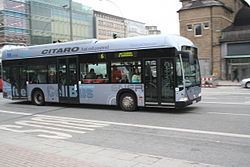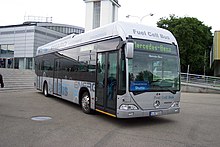Mercedes-Benz Citaro BZ
| EvoBus | |
|---|---|

fuel CellBus of the elevated railway in CUTE paintwork |
|
| Mercedes-Benz Citaro fuel CellBus | |
| Manufacturer | EvoBus |
| design type | City bus , low-floor bus |
| Production period | 2002-2006 |
| axes | 2 |
| power | Fuel cell: 250 kW, electric motor: 225 kW |
| length | 11.95 m |
| width | 2.55 m |
| height | 3,688 m |
| Empty weight | 14,000 kg |
| Perm. total weight | 19,000 kg |
| Previous model | Mercedes-Benz NEBUS |
| successor | Mercedes-Benz Citaro FuelCELL Hybrid |
| Similar models | Van Hool's new A330 Fuel Cell |
The Mercedes-Benz Citaro BZ (BZ for fuel cell ) with the official designation O 530 BZ was called the Fuel Cell Bus at the presentation and is the successor to the Nebus . The 37 vehicles built so far (one prototype and 12 × 3 vehicles) demonstrated suitability for everyday use in nine European cities ( Amsterdam , Barcelona , Hamburg , London , Luxembourg , Madrid , Porto , Stockholm , Stuttgart ) in the CUTE project and in Reykjavík in the ECTOS project , as well as in Perth ( Australia ) the STEP project and under UNEP in Beijing ( China ). The successor model is the Mercedes-Benz Citaro FuelCELL-Hybrid .
The prototype based on the Mercedes-Benz Citaro was presented in 2002. The vehicle is based on the Citaro with the engine stationary and three doors. The internal combustion engine was replaced by an asynchronous motor. The nine hydrogen tanks (1845 liters at 350 bar), the two fuel cell stacks from Ballard Power Systems as well as the electronics and fans are located in a roof structure. The bus has a range of 250 kilometers on one tank of fuel, which corresponds to about a day's tour. The first bus from the series was handed over to the Madrid Transport Authority at the UITP Congress 2003 in Madrid. The other European buses followed in the same year. In 2004 Perth got the three buses and Beijing in 2005.
The buses in London and Perth are right-hand drive and have two doors on the left because the engine has remained in the rear on the left.
After the CUTE project ended in 2006, Porto, Stockholm and Stuttgart dropped out. The other cities continued the tests under the new HyFLEET: CUTE project until 2007.
As part of this project, Hamburger Hochbahn also took over the buses from Stockholm and Stuttgart, so that between 2006 and 2010 the largest fleet of fuel cell buses was on the road with nine vehicles.
The Hamburger Hochbahn had tested another variant of the fuel cell bus from 2010. For this purpose, this technology was combined with hybrid drive technology . Ten 12-m Citaro FuelCELL-Hybrids were in service in Hamburg on the Hamburger Hochbahn in 2011. With a 10–25% reduction in fuel consumption, the vehicles have a tank volume of just 35 kilograms compared to 45 kilograms for a Citaro FuelCell. The batteries have a capacity of 27 kWh. The electric drive is implemented via wheel hub motors with a total output of 120 kW. 4 vehicles have been running on the factory premises of the Frankfurt-Höchst industrial park since 2019.
Depending on the country and registration, the vehicle has 60 to 70 spaces.
Web links
- http://www.daimler.de
- http://www.fuel-cell-bus-club.com for CUTE
- http://www.global-hydrogen-bus-platform.com for HyFLEET: CUTE
- Everything about the Hamburg fuel cell buses; u. a. a lot of pictures
Individual evidence
- ↑ www.hochbahn.de ( page no longer available , search in web archives ) Info: The link was automatically marked as defective. Please check the link according to the instructions and then remove this notice.
- ↑ Regional traffic 6/2009 "No pollutants at all"
- ↑ Four more fuel cell buses for the Höchst industrial park . H2BZ Initiative Hessen, 2019.


